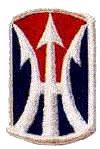

The 11th Infantry Brigade was originally organized in the Regular Army on December 4, 1917 at Camp Forrest, Georgia, as an element of the 6th Division and served as part of the division during World War I. The brigade was credited with two campaign participations during World War I: Alsace 1918 and Muese-Agronne.
After inactivation in 1921, the 11th Brigade was assigned on inactive status. The 11th Brigade was reconstituted on April 15, 1966 as a Regular Army unit, and was reactivated on July 1, 1966 at Schofield Barracks, Hawaii. Under the new organization, the 11th Brigade consisted of the following units:
Beginning in early 1967, the brigade trained extensively in jungle operations in preparation for commitment to Vietnam. To stress realism in the Vietnam-oriented tactical training, the brigade conducted "live-fire' operations in the rugged, thickly-vegetated terrain of the Koolau Mountains on the island of Oahu.
The advance party, consisting of 350 personnel with representation from all brigade units, departed Hawaii by aircraft on November 28, 1967, for Duc Pho, Quang Ngai Province, I Corps Tactical Zone, Republic of Vietnam.
Prior to joining the Americal Division, intensive in-country training was conducted for a month. Upon completion of this training, the 11th Infantry Brigade moved from Landing Zone Carentan to their permanent base camp at Landing Zone Bronco, near Duc Pho, in late January 1968. A fourth infantry battalion, the 4th Battalion, 21st Infantry, joined the "Jungle Warriors" in April 1968. Successful operations during this time included Operation Norfolk Victory, Champagne Grove, and Vernon Lake II. During these operations, the brigade succeeded in destroying the enemy's major bases of operation, weapons and munition caches, rice and salt caches, and interdicting his major infiltration and logistical routes.
The 11th Infantry Brigade operated from five forward fire support bases, each strategically located to hinder the enemy's movement and interdict his traditional lines of infiltration.
Source: the americal division, "under the southern cross" - published by the U.S. Army in 1971.
